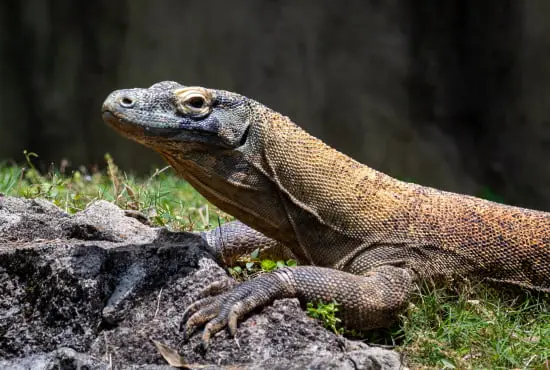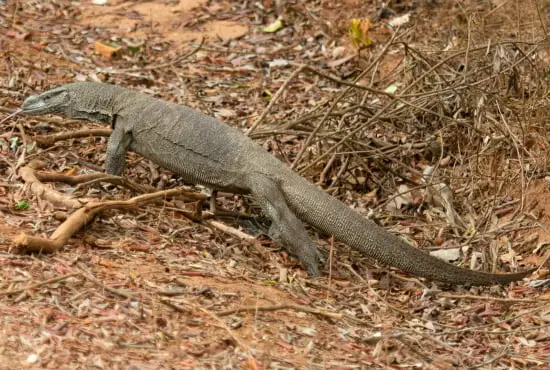Overview
Monitor lizards are large lizards in the genus Varanus. They are native to Africa, Asia, and Oceania, and one species is also found in the Americas as an invasive species (the water monitor). Monitor lizards have long bodies, strong limbs, hooked claws, rows of plates on their backs, and small pointed heads. They range in size from 1 ft (30 cm) to 10 ft (3 m) in length depending on the species.
The monitor lizards are in a family called Varanidae. The members of Varanidae have a wide range in their diet, from eating insects to being carnivores. Most monitor lizards have unique characteristics that set them apart from other lizards, such as their large size and ability to rotate their backbones. All monitor lizards will lay eggs for reproduction with exception of one species that give live birth (Kluge 2005). Monitor lizards also vary by color ranging from yellow to brown or even black depending on which species they are. They are recognized as one of the most diverse and strongest reptiles in the world today (Kluge 2005).

Unusual features that make them unique
they have special feet with pads on their toes to help them climb trees and they can grow up to 6 feet long. They also have a huge, muscular tail that is used for balance while climbing. They can go very long periods without food or water and are excellent swimmers. Monitor lizards are used by some people in Asia as pets because they make such good companions.
Monitor Lizard Facts – Did you know?
Like snakes, monitor lizards are ectothermic, which means their body temperature is determined by their environment. Their blood vessels can constrict and expand to help them maintain the desired body temperature. Also, like snakes, they use external heat-sensing organs to regulate their internal body temperature. They have one eye with a blind spot on each side of it; because of that, they rely heavily on smell and touch when hunting and traveling. This species lays from 5-30 eggs at a time; depending on how many eggs are laid, females may only lay once every 2-4 years or so. This species is considered the least concern for extinction by IUCN’s Red List.

How Big do Monitor Lizards Get?
Size varies among species, but monitor lizards can grow to be quite large, measuring 8 feet in length and weighing up to 400 pounds. In addition to their large size, they are equipped with sharp claws, powerful jaws, and sharp teeth that allow them to subdue prey several times their weight. They also have keen eyesight, an excellent sense of smell, and can be very quick and agile on land. The largest species are capable of eating prey as large as pigs or small deer! If you live in a part of the world where monitor lizards are present, it’s important to stay safe around them and learn how to identify them.
What Do Monitor Lizards Eat?
If you’re looking to keep monitoring lizards as pets, or simply see them in their natural habitats, it’s important to know what they eat. Monitor lizards are carnivores and mostly feed on birds, snakes, frogs, and insects. They can swallow prey that is larger than their head by using an expandable chamber in their throats known as a. This ability is also referred to as gape-limited predation because monitor lizards with smaller gape limits (the distance between their jaws) will not be able to eat prey that is bigger than they are. One of these reptiles most commonly seen feeding in zoos is an Indian giant flying lizard (or two-fingered lizard), which can swallow small mice whole.

Where Can I See a Monitor Lizard in The Wild?
There are numerous places to find monitor lizards in their natural habitat. Seven species of monitor lizards live in sub-Saharan Africa, and all but one of them can be found in South Africa. Of those species, two can be found throughout most of South Africa: Abbott’s monitor (Varanus Acanthurus) and spur-thighed tortoise-lizard (Varanus brevicaudis). It’s very easy to spot these lizards since they’re large—Abercrombie’s monitor can grow up to 3 feet long—and will sit around on rocks or vegetation during warm times of the day. When you see a large lizard basking out on an open area, don’t approach it because it may bite if it feels threatened.
Monitoring – Why We Need to Monitor
The average life span of a monitor lizard is 16 years. This is not very long compared to other animals and makes monitoring these species important because population size estimates help conservationists to understand what threats and steps need to be taken to keep them protected. As well as giving us information on how many adults there are in a population, populations also need to be monitored so that we can understand how their populations are changing over time, which then allows us and agencies like The International Union for Conservation of Nature (IUCN) or World Wildlife Fund (WWF)to see if any of our current conservation efforts are working. If we do not monitor these species then we will never know how effective our efforts were.

